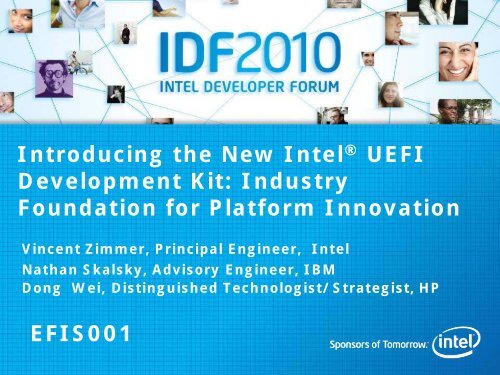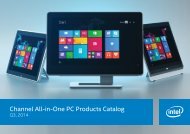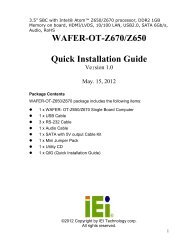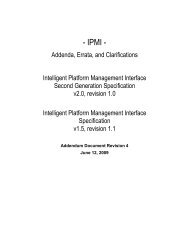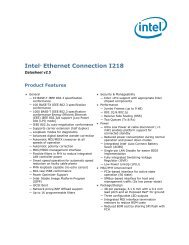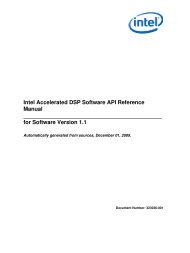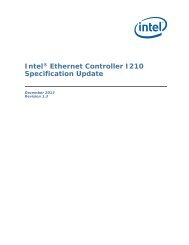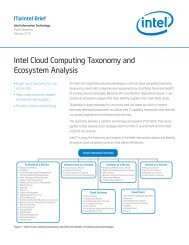Introducing the New Intel® UEFI Development Kit: Industry ...
Introducing the New Intel® UEFI Development Kit: Industry ...
Introducing the New Intel® UEFI Development Kit: Industry ...
- No tags were found...
You also want an ePaper? Increase the reach of your titles
YUMPU automatically turns print PDFs into web optimized ePapers that Google loves.
<strong>Introducing</strong> <strong>the</strong> <strong>New</strong> Intel ® <strong>UEFI</strong><strong>Development</strong> <strong>Kit</strong>: <strong>Industry</strong>Foundation for Platform InnovationVincent Zimmer, Principal Engineer, IntelNathan Skalsky, Advisory Engineer, IBMDong Wei, Distinguished Technologist/Strategist, HPEFIS001
Agenda• Latest <strong>UEFI</strong> specs releases• Intel ® <strong>UEFI</strong> <strong>Development</strong> <strong>Kit</strong>2010 (Intel ® UDK 2010) KeyFeatures• IBM Experience• HP Experience• Summary2
Agenda• Latest <strong>UEFI</strong> specs releases• Intel ® <strong>UEFI</strong> <strong>Development</strong> <strong>Kit</strong>2010 (Intel ® UDK 2010) KeyFeatures• IBM Experience• HP Experience• Summary3
<strong>Industry</strong> BIOS TransitionPre-20002000200420052010All Platforms BIOSwere proprietaryIntel invented <strong>the</strong>Extensible FirmwareInterface (EFI) andprovided sampleimplementation underfree BSD termstianocore.org, opensource EFI communitylaunchedUnified EFI (<strong>UEFI</strong>)<strong>Industry</strong> forum, with 11members, was formed tostandardize EFI160 members and growing!Major MNCs shipping; <strong>UEFI</strong>platforms crossed 50% of IAworldwide units; Microsoft*<strong>UEFI</strong> x64 support in Server2008, Vista* and Win7*;RedHat* and Novell* OSsupport4
<strong>UEFI</strong> Platform InitializationOverview<strong>UEFI</strong> PI Scope - Green “H”OS(<strong>UEFI</strong> orToday’s)<strong>UEFI</strong> SpecificationPlatformDriversSiliconComponentModulesHardwarePre-bootToolsPEI/DXE PI FoundationModular componentsHuman UserGUIApplicationLibrariesDriversNetworkOSFirmwareHardwareFull system stack(user -> hardware)• <strong>UEFI</strong> 2.3 specifies how firmware boots OSloader• <strong>UEFI</strong>’s Platform Initialization (PI) 1.2Architecture specifies how Driver ExecutionEnvironment (DXE) Drivers and Pre-EFIInitialization (PEI) Modules (PEIMs) initializeSI and <strong>the</strong> platform• DXE is preferred <strong>UEFI</strong> Implementation• PEIMs, <strong>UEFI</strong> and DXE drivers implementsnetworking, Update, o<strong>the</strong>r security features5
<strong>UEFI</strong> Specification TimelineSpecifications<strong>UEFI</strong> 2.0PI 1.0<strong>UEFI</strong> 2.1http://uefi.orgPI 1.1<strong>UEFI</strong> 2.2Shell 2.0<strong>UEFI</strong> 2.3PI 1.2Packaging 1.020062007200820092010SCT <strong>UEFI</strong>2.0SCT <strong>UEFI</strong>2.1Implementation6EDK 1.01:<strong>UEFI</strong> 2.0SCTPI 1.0EDK 1.04:<strong>UEFI</strong> 2.1PI 1.0Open SourceEDK 1.05:<strong>UEFI</strong> 2.1+PI 1.0All products, dates, and programs are based on current expectations and subject to change without notice.* EDK II is same code base as UDK2010EDK II*:<strong>UEFI</strong> 2.1+PI 1.0<strong>New</strong>UDK2010:<strong>UEFI</strong> 2.3+PI 1.2+
Agenda• Latest <strong>UEFI</strong> specs releases• Intel ® <strong>UEFI</strong> <strong>Development</strong> <strong>Kit</strong>2010 (Intel ® UDK 2010) KeyFeatures• IBM Experience• HP Experience• Summary7
Intel ® UDK2010 Key Features<strong>Industry</strong> Standard Support:<strong>UEFI</strong> 2.0, <strong>UEFI</strong> 2.1, <strong>UEFI</strong> 2.2, <strong>UEFI</strong> 2.3PI 1.0, PI 1.1, PI 1.2Delivery as Packages (with XML metadata):• Import/export modules source/binaries to many buildsystems• ECP provides reuse of EDK1117 modulesMaximize Reuse of Source Code:• Platform Configuration Database (PCD)• Library Classes/Instances• Optimize for size or speedMultiple <strong>Development</strong> OS:Windows*, Linux*, OSXFast and Flexible Build Infrastructure:• 4X+ Build Performance Improvement (vs EDKI)• Targeted Module Build FlexibilityMultiple Tools Chains:VS2003, VS2005, WinDDK, Intel, GCCExtensible Foundation for Advanced Capabilities:• Pre-OS Security, Rich Networking, Manageability, etc.(e.g. User Identity, Driver/Application signing, IPv6networking, PXE, iSCSI)9Intel® <strong>UEFI</strong> <strong>Development</strong> <strong>Kit</strong> 2010 (Intel® UDK2010)
Intel ® UDK2010 Value PropositionOEMs/ODMs• Reduced <strong>Development</strong> costs (code sharing)• Fast TTM (quick integration, fast build, ref code)• Flexibility to use modules from different suppliers• Quality and Rich <strong>Development</strong> Foundation• Easy to Innovate and DifferentiateEnd Users• <strong>New</strong> standard-based Features (e.g. IPV6/IPSec)• Advanced OEMs Innovative Capabilities• Easy to use and configure systems• Improved UI; Consistent Look & Feel• Intelligent, Efficient and Secure UpdatesIBVs• Common scalable solutions• Improved module deployment efficiency• Support multiple customers efficiently• Alignment with Intel dev foundation directionOSVs• Optimized Boot with Modern Look• Pre-OS system software verification• Enhanced network protocols for deployment• System Boot from large capacity hard drivesSI Vendors/IHVs• IP Protection/Binary Modules deployment oppty• Reduced <strong>Development</strong> costs• Improved Validation and Debug-ability• Comply with OEMs requirements• Multi-Tier Customers EnablingISVs• <strong>New</strong> opportunities for innovation (<strong>UEFI</strong> apps)• Advanced Secure Pre-Boot App environment10Intel® <strong>UEFI</strong> <strong>Development</strong> <strong>Kit</strong> 2010 (Intel® UDK2010)
Spotlight on Select Intel ® UDK2010Features• Packaging• Driver Health• Firmware Management protocol• IP6 Networking• <strong>UEFI</strong> Image Signing• <strong>UEFI</strong> User Identity11Intel® <strong>UEFI</strong> <strong>Development</strong> <strong>Kit</strong> 2010 (Intel® UDK2010)
Packaging: Enabling Fast Delivery of AdvancedCapabilities to MarketMonolithicsource tree/sample/universal//o<strong>the</strong>r/maintained/?FirmwareDeveloperExample of Package-baseddeployment• Package 1 <strong>Industry</strong> standardmodules and drivers• Package 2 Chipset PEIM’s andDXE drivers• Package 3 System board code• Package 4 OEM Value-addUDK2010 enables all <strong>the</strong> pieces to fit toge<strong>the</strong>r and work!
Health and Management• Driver Health Protocol– Allows for self-healing / correcting devices– Drivers and platform boot managerwork in concert to correct & diagnoseissues– Moves more autonomics into<strong>the</strong> platform• Firmware Management Protocol– Consistent way for driver adapters andsystem board to allow for updates– More manageable elements that can• Update from error/bug• Fix field issue• Prevent roll-back to ‘bad’ image– Extends componentmanageability13Rich set of features for package-driven deployment
IP6 Networking• <strong>UEFI</strong> 2.3 network stackinfrastructure– SAN/Datacenter boot• TCP-based iSCSI• Cryptographic logon• Multi-path/fail-over– IPsec for end-to-end security– Supports US Governmentrequirements for IPV6 transitionhttp://www.antd.nist.gov/usgv6/usgv6-v1.pdf• Technology includes– IP4/6, UDP4/6, TCP4/6, DHCP4/6,VLAN, IPsec• Allows for concurrent networkapplications via design based uponMNP• Features dual stack: IP4, IP6, orboth– Evolution of network boot to IPV6• Defined in IETF RFC 597014US Government moving to IPV6 for equipment procurement
<strong>UEFI</strong> Driver Signing• Adds policy around <strong>UEFI</strong>and its 3 rd party imageextensibility– Admixture of OS loaders,apps, and drivers in system– Gives IT control around <strong>the</strong>seexecutables– Detects/prevents malware• Technology includes– Supports “known-good” and“known-bad” signaturedatabases– Policy-based updates to list– Rich signature types• SHA-1, SHA-256,RSA2048/SHA-1,RSA2048/SHA-256 &Au<strong>the</strong>nticode*MS-DOS* HeaderPE Header OffsetPE HeaderSections DirectorySection #1Section #2….Sections #NDebug InformationCertificate #1Certificate #2…Certificate #3PE SignatureStandard HeaderOptional HeaderOptional DataDirectoryImage Data DirectoryIDD entry #1IDD entry #2IDD entry #3IDD entry #4IDD entryCertificate Table1515Extensible integrity architecture
<strong>UEFI</strong> User Identification• Facilitates appropriate userand platform administratorexistence– Ensures ‘right’ party appliespolicy/changes– Keeps out hacker/unlawful user• Technology includes– Uses <strong>UEFI</strong> Human InterfaceInfrastructure (HII) to displayinformation to <strong>the</strong> user– Introduces optional policycontrols for connecting todevices, loading images andaccessing setup pages– A standard framework for userau<strong>the</strong>nticationdevices• Network auth protocols, Smart cards,smart tokens & fingerprint sensors1616Support Extensible for various integrity pre-boot architectureau<strong>the</strong>nticators
Intel ® UDK2010 Putting it All toge<strong>the</strong>rShell ECP Security Network/IScsi MdeIntel UDK2010 Packages• <strong>UEFI</strong> 2.2, 2.3, PI 1.1, 1.2• <strong>UEFI</strong> 2.3 and PI1.2 definitions• <strong>UEFI</strong>2.3/PI 1.2 Tool updates• Backward compatible solution for PI1.1 SMM/S3/SMBIOS• IP4 stack update for IP6-readiness• IP6 stack, ISCSI, PXE, Ipsec, VLAN• Configuration Tools• User identification• Au<strong>the</strong>nticated Variable• Driver Signing• Compatibility package• <strong>UEFI</strong> Shell 2.0Silicon Packages• Platform, chipset & CPUPlatformROM Image• Build system17Intel® <strong>UEFI</strong> <strong>Development</strong> <strong>Kit</strong> 2010 (Intel® UDK2010)Advanced <strong>Development</strong> EnvironmentModular. Flexible. Extensible.
Intel ® UDK2010 Available ontianocore.orgtianocore.orgIntel ® UDK2010Open Source<strong>UEFI</strong> <strong>Development</strong> <strong>Kit</strong>Develop. Contribute. Advance.http://www.tianocore.Sourceforge.net18Intel® <strong>UEFI</strong> <strong>Development</strong> <strong>Kit</strong> 2010 (Intel® UDK2010)
Agenda• Latest <strong>UEFI</strong> specs releases• Intel ® <strong>UEFI</strong> <strong>Development</strong> <strong>Kit</strong>2010 (Intel ® UDK 2010) Keyfeatures• IBM Experience• HP Experience• Summary19
AgendaIBM Experience“Smarter Firmware for a Smarter Planet”Nathan C. SkalskyAdvisory Firmware Engineer, IBMSeptember 13 th , 2010• Summary of IBM’s commitment to <strong>UEFI</strong>, key milestones andbusiness results• <strong>UEFI</strong> vs. BIOS; Why <strong>UEFI</strong> brings value to IBM’s Customers• What IBM looks for in a next-generation <strong>UEFI</strong> development kit(UDK2010)• UDK2010 Key benefits for <strong>UEFI</strong> development• System x firmware development model• Examples of IBM UDK2010 Value Add Packages• EDKI Pain Points vs. UDK2010 Benefits• UDK2010 Key Conceptual Improvements• Summary20
IBM’s Major <strong>UEFI</strong> Milestones21• Mid-2007– <strong>UEFI</strong> Pilot Project and EDKI-based Coredevelopment Kickoff– IBM actively participates in <strong>UEFI</strong> and PIindustry workgroups• Early 2009– First <strong>UEFI</strong>-compliant IBM x86 productfamily launches (Xeon* 5500 blade,modular, and tower systems)• <strong>UEFI</strong> 2.1 and PI 1.1 Compliance– EDKII transition begins• Early 2010– Second major <strong>UEFI</strong>-compliant productfamily launches (Xeon 6500/7500) basedon EDKII <strong>UEFI</strong> Core• Sept 2010– Over 1 Million Class 2 <strong>UEFI</strong>-compliantIBM x86 Servers Shipped• Future UDK 2010– Migration of IBM value-add/differentiationinto EDKII native packages/library-class• <strong>UEFI</strong> 2.3 and PI1.2 Compliance (UDK2010)
IBM <strong>UEFI</strong> Key Features and BenefitsKey FeatureEasier configurationand managementSimplified errorhandlingAbilities beyondlegacy BIOSCustomer Benefits• Ability to configure machines remotely with<strong>the</strong> Advance Settings Utility• In-band and out-of-band firmware update• Remote configuration which lowers TCO byreducing upgrade downtime and makingplatforms easier to manage and deploy• No more cryptic event logs and reduction ofout date errors in BIOS• Beep codes now covered completely by lightpath diagnostics• No limits on number of adapter cards (nomore 1801 resource errors*)• Ability to manage adapter configuration out of“F1 Setup”• Ability to run pre-boot env. in 64-bit mode• Ability to boot storage partitions larger than2.2TB22
IBM’s <strong>UEFI</strong> Success Factors• <strong>UEFI</strong> supported <strong>the</strong> most extensive IBM enterprise-classx86 portfolio launch in System x history (eX5)“Without <strong>UEFI</strong> and <strong>the</strong> common code model it supports, wewould not have been able to execute and achieve time tomarket delivery of multiple server offerings concurrently” -Akhtar Ali Vice President, Blades & Modular Software <strong>Development</strong> for IBMSystems and Technology Group• Over 1million <strong>UEFI</strong>-compliant IBM System x Servers andBlades shipped to customers– 14 Product offerings ranging from entry-level towers, midrangemodular, HPC Cluster, and enterprise-classleadership 4-socket scalable systems– Transition occurred within normal product refresh cyclewithout adverse impact to product launch schedules23
What We Look for in a Next Generation<strong>UEFI</strong> <strong>Development</strong> EcosystemPlatform for Innovation &DifferentiationSecure, Stable, Scalable andOptimized FoundationFlexibility and Faster Time toMarketReduced Integration &Validation TimePlug-in Modules from differentsuppliersEasy to Use, Fast, Rich,Flexible <strong>Development</strong>EnvironmentReduced <strong>Development</strong> CostsStandards ComplianceFact: UDK enables firmware engineers anddevelopers to innovate not just enableFact: Quality foundation code has been good& improving, and is critical to our businessIBM Management: “We have a marketopportunity, can <strong>UEFI</strong> team deliver?” (yes)Fact: Stronger “Common-Family” modelbenefits IBM and its customers (Consistency)Fact: UDK/EDKII packages enable higherquality, on-time delivery of subsystemsIBM Management: “Work smarter not harder”IBM Management: “Lets do 4 more projectssimultaneously this time” (No problem)Customer: “It just works”24
UDK <strong>Development</strong> BenefitsPackagesIntegrationeffortDeveloperefficiency• Package(s) cancome fromdifferentproviders, such asTianoCore, IHV,etc.• Ability to selfcontainfunctionality andbetter managedependencies• Reduce integrationeffort with packagebased release– Dramatically lowerintegration time formerging updates– More able to “divideand conquer”• Improve developerefficiency– Improved build time– Better codedocumentation– Strong/Explicit packagestructure to supportisolation and cleanCore/Platform model– <strong>New</strong> features such asPCD, Library class toallow common functionto be extendedsafely/efficiently25 25
UDK2010 Customers & OEMBenefitsImproved standardization, feature set and consistency• EDKII core code follows <strong>the</strong> <strong>UEFI</strong> and PI standards closely.• <strong>New</strong> features, delivered in UDK2010 packages, can reachcustomers sooner due to better code containment andease of integration• More consistent user experience and operation since morecode is shared (between platforms and generations)Easy for OEM vendor to personalize, brand and extend• OEM vendors can set a look and feel through PCD andIBMs OEM firmware volume toolkit• OEM vendors can extend functionality through addingsigned drivers to <strong>the</strong> OEM firmware volume26Intel® <strong>UEFI</strong> <strong>Development</strong> <strong>Kit</strong> 2010 (Intel® UDK2010)
IBM UDK-based Common Core‘Hexagon’ <strong>Development</strong> ModelPlatform UniquenessChipset FamilyIBM Innovation / Value FeaturesPowerRASCFG UIBOFMSecureUDK2010 Foundation<strong>UEFI</strong> 2.3 Framework27Intel® <strong>UEFI</strong> <strong>Development</strong> <strong>Kit</strong> 2010 (Intel® UDK2010)
IBM UDK2010 Value-Add in actionSystemsMgmtCFG• Out-of-Band Configuration of <strong>UEFI</strong> HII Configuration Database• Out-of-Band <strong>UEFI</strong> Firmware flash updates• Touch-less Out-of-Box experience deploying both <strong>UEFI</strong> and LegacyOperating Systems (integrated boot management)SecuritySecurity• Leadership Pre-boot and runtime security technologies including secureupdates, TPM support and CRTM measured pre-boot codeEnergyMgmtPower• Active Energy Manager: Advanced Power Monitoring, capping, throttlingand management capabilities to extend MIPS-per-Watt value propositionEnterpriseRAS28RAS• DIMM Predictive Failure Alert Technology• Integrated Memory Diagnostics• Advanced Memory Fault Isolation• AER PCIe Error Reporting• <strong>UEFI</strong> Service Data Capture on critical eventsIntel® <strong>UEFI</strong> <strong>Development</strong> <strong>Kit</strong> 2010 (Intel® UDK2010)
IBM UDK2010 Value-Add inaction (cont.)LegacySupportCSM• IBM Surepath CSM (Legacy x86 BIOS support for legacy OSsupport)- Touch-less CSM invocation - auto detection of boot target- Full support of legacy Option ROMsVirtualizationSRIOV,VT• SRIOV – Ability to share adapter physical functions acrossmultiple guest OS instances.• Intel Virtualization Technology Support (VT)EnterpriseScalabilityeX5• Intel ® Xeon ® 7500 Support• Intel ® QPI Scalability• IBM EXA Scalability• MAX5 Memory Expansion Support• FlexNode Technology29Intel® <strong>UEFI</strong> <strong>Development</strong> <strong>Kit</strong> 2010 (Intel® UDK2010)
EDKI vs. UDK2010 Features• EDKI Challenge: Large amount of source code (compared to typicalBIOS implementations), longer and more involved build process, extendedcode review time needed– UDK2010 Solution: UDK2010 Packages allow IBM to manage code at <strong>the</strong>feature/technology level making division of labor cleaner and moreefficient– UDK2010 Solution: UDK2010 doxygen-style commenting makes codereview, API reference, and education far easier to accomplish• EDKI Challenge: Overriding/extending core features requires platformteam to take ownership and manually merge updates– UDK2010 Solution: Library Class/Instance concept allows platform teamsto define custom implementations for standard interfaces• EDKI Challenge: BIOS developers need ‘context shift’ and time tobecome proficient <strong>UEFI</strong> developers– UDK2010 Solution: Improved in-code documentation and logical coderesourcegrouping (packages) have improved bring-up time of new talent30Intel® <strong>UEFI</strong> <strong>Development</strong> <strong>Kit</strong> 2010 (Intel® UDK2010)
IBM Experience ConclusionParity+: EDKI enabled IBM to efficiently transition itsentire range of x86 offerings from BIOS to <strong>UEFI</strong> 2.1 ontimeand without disruption in <strong>the</strong> pre-boot feature setParity++: EDKII enabled IBM to reach beyond functionalparity and innovate with our eX5 enterprise-class systemsInnovation+: UDK2010 is enabling IBM to fur<strong>the</strong>r extendits x86 pre-boot technology leadership by providing a robust<strong>UEFI</strong> 2.3/PI 1.2 development environment from which todeliver, package, and distribute advanced pre-boottechnology31Intel® <strong>UEFI</strong> <strong>Development</strong> <strong>Kit</strong> 2010 (Intel® UDK2010)
Agenda• Latest <strong>UEFI</strong> specs releases• Intel ® <strong>UEFI</strong> <strong>Development</strong> <strong>Kit</strong>2010 (Intel® UDK 2010) Keyfeatures• IBM Experience• HP Experience• Summary32
The Next Era of Mission-Critical ComputingEDK II Transition on <strong>the</strong> First Mission-CriticalConverged InfrastructureDong Wei – Distinguished Technologist/StrategistSept 13, 2010
Mission-Critical Customer ChallengesFinancial ServicesEvery minute ofdowntime = a minute oflost revenue!Manufacturingand DistributionProduction comesto grinding haltHealthcarePatient outcomesdepend on 24x7access to dataPublic Sector,and Communications,Media & EntertainmentCustomer retentionand fraud detection at riskNo tolerance for downtimeIncreasing Service Level Agreements with decreasing budgetsIslands of legacy apps and monolithic systems34Hewlett-Packard Company makes no warranty as to <strong>the</strong> accuracy or completeness of <strong>the</strong>foregoing material and hereby disclaims any responsibility <strong>the</strong>refor.
The First Mission-Critical ConvergedInfrastructure<strong>New</strong> Integrity systems optimized for <strong>the</strong> converged infrastructureStorageHPConvergedInfrastructureServersPower &coolingNetworkManagementsoftwareA common, modular architecturethat simplifies, consolidates, andautomates everythingA mission-criticalinfrastructure delivering <strong>the</strong>highest levels of reliability andflexibility35Hewlett-Packard Company makes no warranty as to <strong>the</strong> accuracy or completeness of <strong>the</strong>foregoing material and hereby disclaims any responsibility <strong>the</strong>refor.
What HP looks for in FirmwareHP Firmware Requirements• Advanced Features support• Path to support network boot over IPv6, etc.• HP Platform Innovations• Platform value-add modules• Protect intellectual property• Improve Execution Excellence• Limited engineering resources• Faster time to market• Separate <strong>the</strong> hardware basic execution away from HP innovations• Reduced Integration & Validation Time• Used packaging supplied by Silicon driver modules from Siliconsupplier• Maximize proper code reuse• Build-once, use by multiple platforms36Hewlett-Packard Company makes no warranty as to <strong>the</strong> accuracy or completeness of <strong>the</strong>foregoing material and hereby disclaims any responsibility <strong>the</strong>refor.
Integrity † Leads HP EDK II TransitionEDK II Enables HP Platform Innovation and Execution ExcellenceSingle Source TreeFor Superdome 2,Blades and RackServersSuperdome 2The ultimate mission-criticalconsolidation platformSuperior PackagesAbility to reuseSingle module/solutionownerGlobal visibility for bug fixc3000Integrity Server Bladesc7000ECP Works WellReuse existing siliconmodules, applicationsBladeSystem Matrixwith HP-UXFirst ConvergedInfrastructureplatform for shared services,now mission-criticalIntegrity 2s Rack Server8-core scalability in 3xless compute density—without sacrificing RAS37Hewlett-Packard Company makes no warranty as to <strong>the</strong> accuracy or completeness of <strong>the</strong>foregoing material and hereby disclaims any responsibility <strong>the</strong>refor.
HP Contributions to EDK IIAn Early Adopter• Provided review/guidance that helped to refine EDKII to <strong>the</strong> present form• Provided multiple feedback on simplification• Recommended <strong>the</strong> use industry-standard toolsinstead of proprietary tools• Provided fixes of build tool bugs• Identified EDK II issues that arose when enablingcompiler optimization with <strong>the</strong> Intel C compiler.• Discovered multiple EDK II bugs− For example, a subtle design issue with <strong>the</strong> <strong>UEFI</strong> network stack thatleads to severe performance degradation on large systemsHP Contributions benefited <strong>the</strong> entire opensourcecommunity38Hewlett-Packard Company makes no warranty as to <strong>the</strong> accuracy or completeness of <strong>the</strong>foregoing material and hereby disclaims any responsibility <strong>the</strong>refor.
<strong>UEFI</strong> Transition Recommendations<strong>Development</strong> Challenge• Code development required large-scale source tree updates• Updates needed on average every 2-3 months• Expected in early adoption phaseUDK2010 addresses this challenge through code base maturity,packaging technology, and catching up with <strong>the</strong> latest specsDevelopers Recommendation• Pay close attention to <strong>the</strong> specifications/errata• Parallel versions for different spec versions• Maintain <strong>the</strong> infrastructure support and compatibility– Keep “deprecated” version of lib/include/PCD– Avoid changing build tools/lib/include/PCD• Proactively communicate when a bug is fixed39OEMs/IBVs Recommendation• Take advantage of parallel versions if available– Get small-scale source updates needed• Pull in <strong>the</strong> latest code at least every 2 months• Use EDK II package solution– Create vendor-specific modulesHewlett-Packard Company makes no warranty as to <strong>the</strong> accuracy or completeness of <strong>the</strong>foregoing material and hereby disclaims any responsibility <strong>the</strong>refor.
Summary• Intel ® UDK2010 meets <strong>the</strong> OEMs advancedrequirements for platform development andenables common firmware foundation across<strong>the</strong> compute continuum• Intel UDK2010 enables IBM to developconsistent cross-platform ‘core’ code stackwith advanced configuration, reliability, andboot management features• EDK II/Intel UDK2010 enables HP PlatformInnovations and Excellent Execution• Intel UDK2010 is available on tianocore.org40Intel® <strong>UEFI</strong> <strong>Development</strong> <strong>Kit</strong> 2010 (Intel® UDK2010)
Additional sources ofinformation on this topic:• O<strong>the</strong>r Sessions – See Next Slide• Demos in <strong>the</strong> showcase – #160• Additional info in <strong>the</strong> SSG community – EFI Booth• More web based info:– UDK 2010 - http://www.tianocore.Sourceforge.net– <strong>UEFI</strong> Specifications - http://www.uefi.org• Books on topic:– Beyond BIOS 2 nd edition - Intel Press– IBM’s “<strong>Introducing</strong> <strong>UEFI</strong> on IBM System x and BladeCenterServers” Whitepaper• http://www-947.ibm.com/support/entry/portal/docdisplay?brand=5000008&lndocid=MIGR-5083207– http://h20000.www2.hp.com/bc/docs/support/SupportManual/c01717787/c01717787.pdf?jumpid=reg_R1002_USEN– http://h20195.www2.hp.com/v2/GetPDF.aspx/4AA2-2423ENW.pdf41
Intel ® UDK2010 Available ontianocore.orgtianocore.orgIntel ® UDK2010Open Source<strong>UEFI</strong> <strong>Development</strong> <strong>Kit</strong>Develop. Contribute. Advance.http://www.tianocore.Sourceforge.net42Intel® <strong>UEFI</strong> <strong>Development</strong> <strong>Kit</strong> 2010 (Intel® UDK2010)
Beyond BIOS 2nd edition promotionVouchers available in session room and<strong>UEFI</strong> Technology showcase booth #16043
<strong>UEFI</strong> PLUGFEST in Taiwan Oct 12-15, 2010Visit www.uefi.org/events for Event Info and Registration44
IDF 2010 <strong>UEFI</strong> Fall SessionsSept. 13, 2010 Moscone Room 2006EFI# Company Description TimeS001 Intel, IBM, HP <strong>Introducing</strong> <strong>the</strong> <strong>New</strong> Intel® <strong>UEFI</strong> <strong>Development</strong> <strong>Kit</strong>:<strong>Industry</strong> Foundation for Platform InnovationS002Intel, LSI, Dell,Phoenix<strong>UEFI</strong> Advancements for Independent HardwareVendors11:00 AM1:05 PMS003 Intel, WindRiver Boot Loader Solutions for Intel® AtomProcessor Based Embedded Devices2:10 PMS004 Intel, Dell, AMI Zero-Touch Platform Manageability with <strong>UEFI</strong> 3:15 PMS005Intel, IBM,InsydeBeyond DOS: The <strong>UEFI</strong> Shell – a Modern Pre-bootApplication Environment4:20 PMQ001 All <strong>UEFI</strong> Q & A session with all Speakers 5:25 PM45 DONE
Please Fill out <strong>the</strong>Session Evaluation FormGive <strong>the</strong> completed form to<strong>the</strong> room monitors as youexit!Thank You for your input, we use it toimprove future Intel Developer Forumevents46
Q&ATweet your questions and comments to@intel_uefi47
Session Presentations - PDFsThe PDF for this Session presentation isavailable from our IDF Content Catalogat <strong>the</strong> end of <strong>the</strong> day at:intel.com/go/idfsessionsURL is on top of Session Agenda Pagesin Pocket Guide48
Legal Disclaimer• INFORMATION IN THIS DOCUMENT IS PROVIDED IN CONNECTION WITH INTEL® PRODUCTS.NO LICENSE, EXPRESS OR IMPLIED, BY ESTOPPEL OR OTHERWISE, TO ANY INTELLECTUALPROPETY RIGHTS IS GRANTED BY THIS DOCUMENT. EXCEPT AS PROVIDED IN INTEL’S TERMSAND CONDITIONS OF SALE FOR SUCH PRODUCTS, INTEL ASSUMES NO LIABILITYWHATSOEVER, AND INTEL DISCLAIMS ANY EXPRESS OR IMPLIED WARRANTY, RELATING TOSALE AND/OR USE OF INTEL ® PRODUCTS INCLUDING LIABILITY OR WARRANTIES RELATING TOFITNESS FOR A PARTICULAR PURPOSE, MERCHANTABILITY, OR INFRINGEMENT OF ANY PATENT,COPYRIGHT OR OTHER INTELLECTUAL PROPERTY RIGHT.• Intel may make changes to specifications and product descriptions at any time, without notice.• All products, dates, and figures specified are preliminary based on current expectations, and aresubject to change without notice.• Intel, processors, chipsets, and desktop boards may contain design defects or errors known aserrata, which may cause <strong>the</strong> product to deviate from published specifications. Currentcharacterized errata are available on request.• Performance tests and ratings are measured using specific computer systems and/orcomponents and reflect <strong>the</strong> approximate performance of Intel products as measured by thosetests. Any difference in system hardware or software design or configuration may affect actualperformance.• Intel, Xeon, Intel Sponsors of Tomorrow. and Intel Sponsors of Tomorrow. Logo and <strong>the</strong> Intellogo are trademarks of Intel Corporation in <strong>the</strong> United States and o<strong>the</strong>r countries.• *O<strong>the</strong>r names and brands may be claimed as <strong>the</strong> property of o<strong>the</strong>rs.• Copyright ©2010 Intel Corporation.49
Risk FactorsThe above statements and any o<strong>the</strong>rs in this document that refer to plans and expectations for <strong>the</strong> second quarter, <strong>the</strong> year and <strong>the</strong>future are forward-looking statements that involve a number of risks and uncertainties. Many factors could affect Intel’s actualresults, and variances from Intel’s current expectations regarding such factors could cause actual results to differ materially fromthose expressed in <strong>the</strong>se forward-looking statements. Intel presently considers <strong>the</strong> following to be <strong>the</strong> important factors that couldcause actual results to differ materially from <strong>the</strong> corporation’s expectations. Demand could be different from Intel's expectations dueto factors including changes in business and economic conditions; customer acceptance of Intel’s and competitors’ products; changesin customer order patterns including order cancellations; and changes in <strong>the</strong> level of inventory at customers. Intel operates inintensely competitive industries that are characterized by a high percentage of costs that are fixed or difficult to reduce in <strong>the</strong> shortterm and product demand that is highly variable and difficult to forecast. Additionally, Intel is in <strong>the</strong> process of transitioning to itsnext generation of products on 32nm process technology, and <strong>the</strong>re could be execution issues associated with <strong>the</strong>se changes,including product defects and errata along with lower than anticipated manufacturing yields. Revenue and <strong>the</strong> gross marginpercentage are affected by <strong>the</strong> timing of new Intel product introductions and <strong>the</strong> demand for and market acceptance of Intel'sproducts; actions taken by Intel's competitors, including product offerings and introductions, marketing programs and pricingpressures and Intel’s response to such actions; defects or disruptions in <strong>the</strong> supply of materials or resources; and Intel’s ability torespond quickly to technological developments and to incorporate new features into its products. The gross margin percentage couldvary significantly from expectations based on changes in revenue levels; product mix and pricing; start-up costs, including costsassociated with <strong>the</strong> new 32nm process technology; variations in inventory valuation, including variations related to <strong>the</strong> timing ofqualifying products for sale; excess or obsolete inventory; manufacturing yields; changes in unit costs; impairments of long-livedassets, including manufacturing, assembly/test and intangible assets; <strong>the</strong> timing and execution of <strong>the</strong> manufacturing ramp andassociated costs; and capacity utilization. Expenses, particularly certain marketing and compensation expenses, as well asrestructuring and asset impairment charges, vary depending on <strong>the</strong> level of demand for Intel's products and <strong>the</strong> level of revenue andprofits. The majority of our non-marketable equity investment portfolio balance is concentrated in <strong>the</strong> flash memory market segment,and declines in this market segment or changes in management’s plans with respect to our investment in this market segment couldresult in significant impairment charges, impacting restructuring charges as well as gains/losses on equity investments and interestand o<strong>the</strong>r. Intel's results could be impacted by adverse economic, social, political and physical/infrastructure conditions in countrieswhere Intel, its customers or its suppliers operate, including military conflict and o<strong>the</strong>r security risks, natural disasters, infrastructuredisruptions, health concerns and fluctuations in currency exchange rates. Intel’s results could be affected by <strong>the</strong> timing of closing ofacquisitions and divestitures. Intel's results could be affected by adverse effects associated with product defects and errata(deviations from published specifications), and by litigation or regulatory matters involving intellectual property, stockholder,consumer, antitrust and o<strong>the</strong>r issues, such as <strong>the</strong> litigation and regulatory matters described in Intel's SEC reports. An unfavorableruling could include monetary damages or an injunction prohibiting us from manufacturing or selling one or more products,precluding particular business practices, impacting our ability to design our products, or requiring o<strong>the</strong>r remedies such as compulsorylicensing of intellectual property. A detailed discussion of <strong>the</strong>se and o<strong>the</strong>r factors that could affect Intel’s results is included in Intel’sSEC filings, including <strong>the</strong> report on Form 10-Q for <strong>the</strong> quarter ended March 27, 2010.Rev. 5/7/1050


